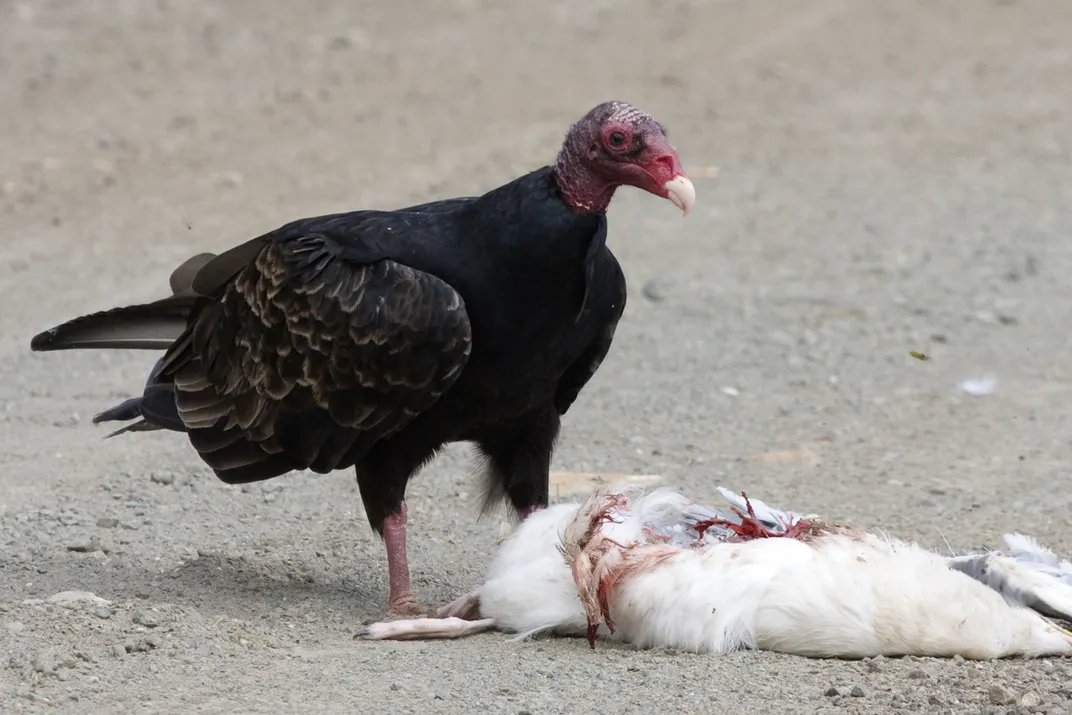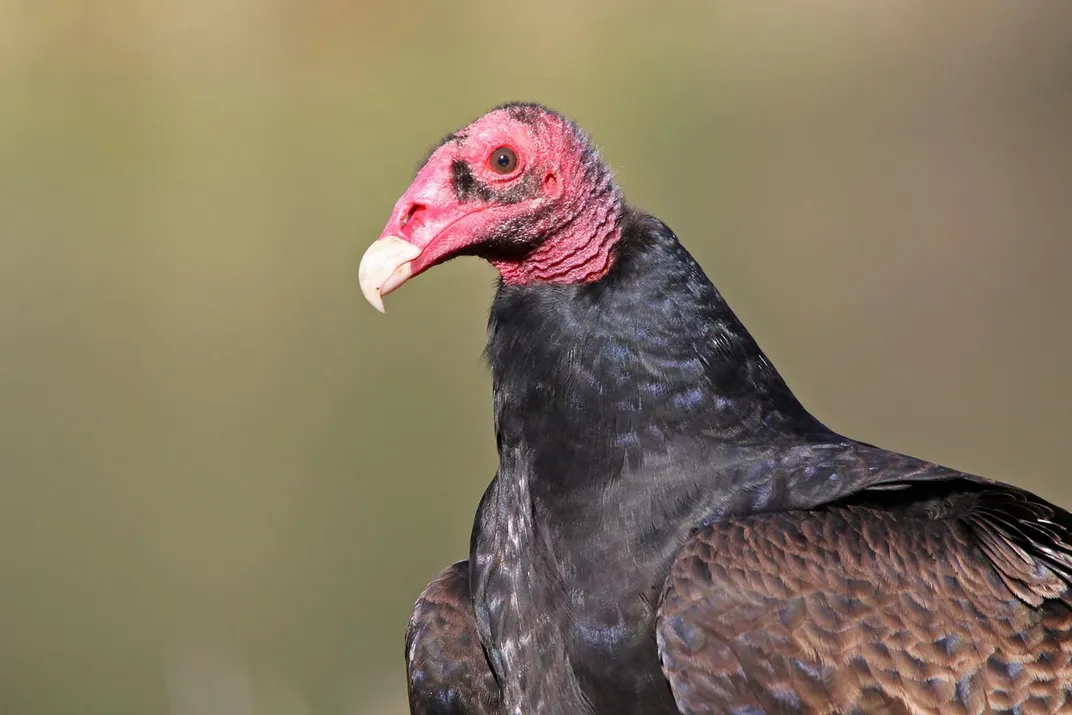Turkey Vultures Have a Keen Sense of Smell and Now We Know Why
Inside the brains of this olfactory king of the roost is a powerful cellular mechanism for detecting carrion from hundreds of feet away
:focal(3789x1520:3790x1521)/https://tf-cmsv2-smithsonianmag-media.s3.amazonaws.com/filer/0a/e2/0ae218a9-b43e-48b5-a5d3-4eb2c98f573d/turkey_vulture_in_flight_1_6022496126.jpg)
Turkey vultures have evolved to have the most finely-attuned sense of smell among nearly all birds, which has also allowed them to be the most ubiquitous of all the 23 vulture species in the world—that’s according to an important new study co-authored by Smithsonian Institution researcher and vulture expert Gary Graves.
The study is the first to definitively prove—through difficult-to-conduct comparative anatomical studies and histology—what has long been surmised by bird watchers: that the high-flying turkey vulture has no match when it comes to navigating to a meal via smell alone.
Without these swooping scavengers, the globe could potentially be looking at a greater incidence of disease or pestilence, and more certainly, a larger body count alongside highways and byways.
A decade ago, a massive die-off of the endemic vulture species in India and Pakistan provides evidence of what can go awry, says Keith Bildstein, interim president and Sarkis Acopian director of conservation science at the Hawk Mountain Sanctuary in Orwigsburg, Pennsylvania. As the birds became almost nonexistent, dogs stepped into the breach and thrived on the carrion that previously was mostly ingested by the vultures. No one is certain why the dogs were not harmed by an arthritis drug in the dead cattle that was found to be felling the vultures. But the dog population exploded, as did the spread of rabies. Some 30,000 Indians die from rabies each year, with the majority of cases caused by dog bites. Scientists believe the inability to keep human rabies deaths in check was correlated with the loss of the vultures, Bildstein says.
The paper by Graves and his colleagues should give people another reason to respect vultures, says Bildstein. “This is a very significant report,” he says, adding that “it’s a slam dunk answer” on the question as to whether turkey vultures (Cathartes aura) indeed have a superior sense of smell.

Turkey vultures are raptors, yet unlike the black vulture (Coragyps atratus), they do not appear to primarily use visual cues to locate their next meal. But that has not been a settled question, and bird experts—going back to the times of the illustrious ornithologist John James Audubon in the mid-1800s—have debated how those species locate carrion.
In the 1960s, Kenneth Stager, a senior curator of ornithology at the Natural History Museum of Los Angeles County, made a breakthrough. Anatomical studies he conducted showed that turkey vultures had an extremely large olfactory bulb—an area of the brain responsible for processing odors—says Graves, curator of birds at the Smithsonian’s National Museum of Natural History in Washington, D.C.
But the debate over how the birds did it raged on, mainly because no one had been able to show at a microscopic level that the turkey vulture’s larger olfactory bulbs conferred any kind of advantage in the smell department.
Like the post-apocalyptic living dead roving the earth in zombie films, scientists needed fresh brains to determine exactly what was going on inside the turkey vulture’s enlarged olfactory bulb.
Fresh brains are not easy to get, says Graves. Vultures are protected by law from hunting, and a special permit is required to collect the birds for scientific research. Given its mission, the Smithsonian has been granted such a permit, but even so, vultures are not purposely executed very often.

In 2012, however, Graves heard about a legal culling operation by the U.S. Department of Agriculture that was to be conducted at Nashville’s airport. He decided it was a chance to make the best out of an unfortunate situation. He and several colleagues loaded up a van and set up a mobile necropsy unit at a warehouse near the airport. “We were there to receive the corpses that ordinarily would be disposed of,” says Graves.
For five days, the researchers processed the birds as they came in. The brains were removed and the heads preserved in formaldehyde. They will be added to the Smithsonian’s collection, making a rare commodity available to researchers for generations to come.
Graves and his colleagues also worked quickly to take hundreds of slices of brain, fixing them for microscopic study.
In their study, published online in Scientific Reports on December 12, they reported that, on average, the turkey vulture has an olfactory bulb that is four times larger than that of the black vulture, and, compared with 143 other species, the bulb is significantly larger relative to brain volume.
In addition, turkey vultures have twice as many mitral cells as black vultures, despite having a brain that is a fifth smaller. Mitral cells, which are found in all animals, help transmit information about smell to the brain, and serve as a proxy for the sensitivity of the sense of smell. This microscopic look was important, because no published data on the number of mitral cells in avian olfactory bulbs exists, say Graves and his colleagues in the study.
“In absolute numbers, the turkey vulture has more mitral cells than any other species measured,” the authors say, noting that they conducted comparison studies against 32 species of 10 different avian orders.
While it may not be a huge surprise—given field observations—that the turkey vulture has a much bigger olfactory bulb, “it’s comforting,” says Bildstein. He was also impressed that Graves’ study was able to pinpoint that black vultures did not have superior eyesight to the turkey vulture, as has been previously thought.
Graves and his colleagues postulate that eons ago, when Cathartes and Coragyps diverged, through the “enlargement of its olfactory system, the turkey vulture was able to occupy a new sensory niche among vultures that depended on olfaction.”
The birds “can smell very diluted plumes of volatile gases in the air column, hundreds of feet above the ground,” says Graves, adding that they “circle around like bloodhounds to seek the source of the odor.”
That sense of smell and the superior ability to find food in closed-canopy forests and jungles (unlike the black and many other vultures, which cannot see carrion in those situations), “has likely contributed to the turkey vulture having the most widespread distribution of any vulture species in the world,” say Graves. An estimated 18 million turkey vultures roam the globe, according to the Cornell Lab of Ornithology.
Bildstein agrees with Graves’ conclusions. The turkey vulture’s superior sense of smell is what is known as a “key innovation” in the evolution of its species, he adds.
In the future, Graves hopes to look even deeper into the turkey vulture’s sense of smell. One avenue of exploration is to determine whether olfactory receptors in the bird’s genome might differ from those of other birds, or humans, or other mammals, he says.
Graves is also interested in looking into what the turkey vultures are actually detecting in those smells. “The odor of death is pretty complex,” he says, noting that it involves hundreds of chemicals. It’s not clear whether turkey vultures are keying in on one particular scent or perhaps a cocktail of odors.
It’s important to keep studying the massive birds—which can have six-foot wingspans—says Graves. They “continuously clean up all sorts of things that could cause human and livestock illnesses,” he says, and save highway departments millions by scavenging road kill.
Humans tend to be unaware of the valuable work the birds are doing while they go about their usual business. “They’re just doing what they’ve been doing for millions of years,” says Graves.
/https://tf-cmsv2-smithsonianmag-media.s3.amazonaws.com/accounts/headshot/AliciaAult_1.png)
/https://tf-cmsv2-smithsonianmag-media.s3.amazonaws.com/accounts/headshot/AliciaAult_1.png)